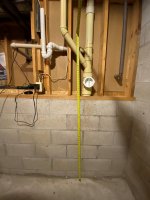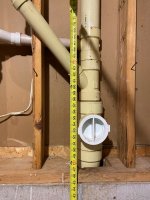I would like to install a washer and dryer in my basement and if possible, avoid using a sink ejection pump system. The house is a quad split, and the plumbing comes halfway down the basement wall as can be seen in the photo. If I was to either build a platform up to 18" high, or use a pedestal to raise it 14" - would that provide a functional height for proper draining from a front load washer. I understand the code is a little aged in this area and was written prior to the abundance of front load washers. More than anything, I am looking to know if there would be any draining concerns or other issues I am overlooking.
And if I was to tie into that busy stack, would you recommend tying into the 2" pipe coming from the wye, or would it be preferred to tear it apart and put in a new 4" x 2" double Wye and come in on the right hand side. Any professional wisdom would be appreciated. If the picture is difficult to see, the height center of the 2" inlet on the Wye is about 63".
Thanks,
Brian
And if I was to tie into that busy stack, would you recommend tying into the 2" pipe coming from the wye, or would it be preferred to tear it apart and put in a new 4" x 2" double Wye and come in on the right hand side. Any professional wisdom would be appreciated. If the picture is difficult to see, the height center of the 2" inlet on the Wye is about 63".
Thanks,
Brian


